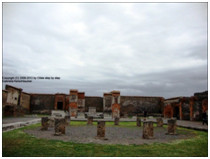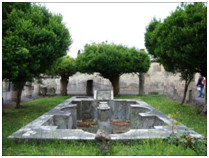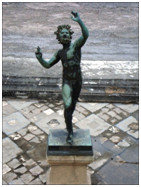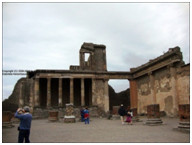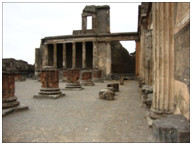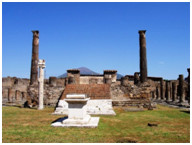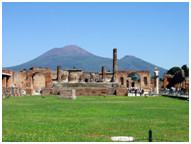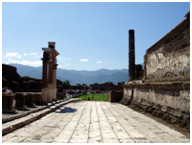Vesuvius and Pompeii
Vesuvius

January 1st to March31st 09:00 - 15:00
April 1st to May 31st 09:00 - 17:30
June 1st to August 31st 09:00 - 18:30
September 1st to October 31st 09:00 - 17:00
November 1st to December31st 09:00 - 15:00
There have been speculations about Vesuvius for thousands of years - thousands of books, reports and papers have been published about this volcano.Due to lack of space for including all the information available, only a fraction of it will be mentioned here.
Since ancient times, it is known that the volcano is located in one of the most picturesque regions of the world.Moreover, people were always fascinated by its lively volcanic activity.
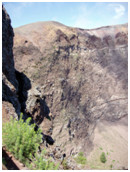 Geologically, it was discovered that the Vesuvius was active repeatedly before 79 AD. With the help of rock examination eruptions from 6000 years BC were detected. The birth of the volcano is said to have taken place about four hundred thousand years ago.
Geologically, it was discovered that the Vesuvius was active repeatedly before 79 AD. With the help of rock examination eruptions from 6000 years BC were detected. The birth of the volcano is said to have taken place about four hundred thousand years ago.
The real saga of the volcano starts with the eruption 79 AD, the first written documentation of one of the largest natural disasters that the world has ever seen.
The exact date though, could not be established precisely until now. Pliny the Younger, in his much-quoted letter to Tacitus, speaks of 24th August. But this may well be a transmission error, which was built up within a few centuries.
Though excavation evidence obtained, indicated that the volcano must have erupted on either October 24th or on November 24th 79 AD. This is based on the contents of the found amphorae (must, wine and autumn fruits such as chestnuts, walnuts, pomegranates, etc.), as well as by the coins, which came into circulation only from September 7th 79 AD.
More information you will find in our guide
In 1997 a huge magma field of 400 cubic kilometres was found 8 km under Vesuvius and Naples. With this a Vesuvius eruption would have sufficient strength to destroy everything in its reach. (Source: Science @ ORF, article in 'Science' (Volume 294, Number 5546, Issue of 16 Nov 2001, pp 1510-1512, in "Seismic Evidence of an Extended Magmatic Sill Under Mt Vesuvius).
The area around Vesuvius is a National Park since 1995.
Source www.vesuvioinrete.it
Year |
Type of outbreak |
Notes |
|
79 |
explosive |
ash, pumice and lahar |
|
472 |
effusive-explosive |
lava streams and lahar direction NW |
|
512 |
??? |
----- |
|
26 Feb. 685 |
effusive |
huge lava flow |
|
787 |
effusive-explosive |
Red-hotlava fountains, lava streams and massive lahar |
|
968 |
??? |
Lava strams to the sea |
|
27 Jan. 1037 |
??? |
Lava strams to the sea |
|
29 May 1139 |
explosive |
Ash rain |
|
1500 |
explosive |
Ash rain |
|
16 Dec. 1631 |
effusive- explosiv |
collapse of the large cone, lava flows to the sea |
|
3 July 1660 |
explosive |
Ash rain to NE |
|
13 April 1694 |
effusive |
Lava to Torre del Greco |
|
25 May 1698 |
effusive- explosive |
damage caused by ash fall towards SE |
|
28 July 1707 |
effusive- explosive |
----- |
|
20 May 1737 |
effusiv- explosiv |
lava flows into the town of Torre del Greco, ash fall and lahar |
|
23 Dec. 1760 |
effusive- explosive |
openings on the southern flanks of the mountain at 150m above sea level |
|
19 Oct. 1767 |
effusive- explosive |
two lava streams to Torre Annunziata, and San Giorgio a Cremano |
|
8 Aug. 1779 |
explosive |
ejections and ash on Ottaviano |
|
15 June 1794 |
effusive- explosive |
openings on the south eastern part of the mountain at 470 m |
|
22 Oct. 1822 |
effusive-explosive |
two lava streams to Torre del Greco and Boscotrecase |
|
23 Aug. 1834 |
effusive-explosive |
lava streams to Poggiomarino |
|
6 Feb. 1850 |
effusive-explosive |
----- |
|
1 May 1855 |
effusive |
lava steams flood Massa and San Sebastiano |
|
8 Dec. 1861 |
effusive-explosive |
openings on the south eastern part of the mountain at 290m above sea level |
|
15 Nov. 1868 |
effusive |
----- |
|
24 April 1872 |
effusive-explosive |
lava streams flood Massa and San Sebastiano |
|
4 April 1906 |
effusive-explosive |
lava streams to Torre Annunziata, strong explosive activity |
|
3 June 1929 |
effusive-explosive |
lava streams to Terzigno |
|
18 March 1944 |
effusive-explosive |
lava streams flood Massa and San Sebastiano |
The term lahar is from the Indonesian and means fast-flowing volcanic mud stream.
Effusion is a more or less quiet outflow of lava
There are few possibilities to reach the Vesuvius.
Early in the morning in Naples you can catch a train, line Circumvesuviana (about every 30 minutes) from Central Station "Stazione Centrale" in Piazza Garibaldi to "Pompeii Scavi-Villa dei Misteri", to visit the main attractions of the archaeological site of Pompeii.
Then, no later than at 14:40, you can take the bus from Pompeii, it returns at 17:40 from Vesuvius. The sightseeing program can be customized, of course, just considered the opening times of the excavation site (see below).
The following services are included in Arte Card:
More information you will find in our guide
Pompeii
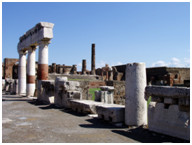 Where is Pompeii ? What is Pompeii ?
Where is Pompeii ? What is Pompeii ?
Pompeii is a “sunken” Roman ruined city near Naples in the Italian region of Campania. It was destroyed and buried during a catastrophic eruption of the volcano Mount Vesuvius in autumn of 79 AD. The volcano buried Pompeii under many meters of ash, and it was lost for more then1,600 years before its accidental rediscovery in 1748. Since then, its excavation has provided an extraordinarily detailed insight into the life of a city at the height of the Roman Empire. Today, it is a main tourist attraction of Italy and a UNESCO World Heritage Site.
Countless books and articles have been written about Pompeii and also in this case, only a short version of its story will be given.
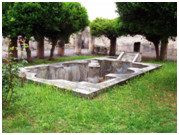 Vesuvius exploded suddenly in 79 AD. The rain of ash and melted lava rock buried Pompeii and some neighbouring towns. Thousands of people lost within a few hours their lives and left evidence of the actual everyday life of ancient times.
Vesuvius exploded suddenly in 79 AD. The rain of ash and melted lava rock buried Pompeii and some neighbouring towns. Thousands of people lost within a few hours their lives and left evidence of the actual everyday life of ancient times.
The formerly official date of the volcanic eruption was August 24th 79 AD.
Most likely a translation error of the much-quoted letter of Pliny the Younger to Tacitus occurred over several centuries, because excavations show that the volcano must have erupted in October or November 79 AD.
Contents of the amphorae (must, wine and autumn fruits such as chestnuts, walnuts, pomegranates, etc.), as well as coins that came into circulation only from September 7th 79 AD (see also under "Vesuvius") bear witness of that.
More information you will find in our guide
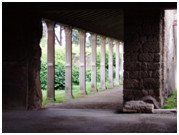 79 AD after the great catastrophe it gradually became quiet around Pompeii. Over the years, the city fell into oblivion - even the knowledge of its geographical location was lost. First traces were found again in 1628, as during work in Sarnotal ruins came to light that aroused the curiosity of scientists.
79 AD after the great catastrophe it gradually became quiet around Pompeii. Over the years, the city fell into oblivion - even the knowledge of its geographical location was lost. First traces were found again in 1628, as during work in Sarnotal ruins came to light that aroused the curiosity of scientists.
Only in 1748, under the Bourbons, excavations were started in Pompeii, zone Civita. There was no plan or method, and convicts in chains, and children were used for the work. The finds were partly labelled. There was no further interest in the rest of the excavations. Many of the most valuable art objects and artefacts were stolen; others served as foundation for the exhibition of the National Museum in Naples. In the royal palaces and castles, some of these art works were found as well, and many other objects disappeared abroad. Since the site was not covered, it was exposed to the weather for decades. Numerous artefacts, but also parts of the archaeological excavation site were destroyed beyond repair.
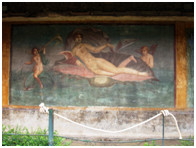 During the French Revolution in 1789 revolts began to arise also in Naples. As a result, the excavations were almost discontinued. Under Joseph Bonaparte, the elder brother of Emperor Napoleon, King of Naples and his successor, King Joachim Murat, the excavations continued in a more sophisticated way. The historic townscape, city planning, architecture and city limits were now the centre of scientific research.
During the French Revolution in 1789 revolts began to arise also in Naples. As a result, the excavations were almost discontinued. Under Joseph Bonaparte, the elder brother of Emperor Napoleon, King of Naples and his successor, King Joachim Murat, the excavations continued in a more sophisticated way. The historic townscape, city planning, architecture and city limits were now the centre of scientific research.
More information you will find in our guide
The following information was took from wikipedia, http://en.wikipedia.org/wiki/Pompeii
Quote
Rediscovery
After thick layers of ash covered the two towns, they were abandoned and eventually their names and locations were forgotten. The first time any part of them was unearthed was in 1599, when the digging of an underground channel to divert the river Sarno ran into ancient walls covered with paintings and inscriptions. The architect Domenico Fontana was called in and he unearthed a few more frescoes but then covered them over again, and nothing more came of the discovery. A wall inscription had mentioned a decurio Pompeii ("the town councillor of Pompeii") but the vital fact that this indicated the name of an ancient Roman city hitherto unknown was missed.[15] Fontana's act of covering over the paintings has been seen both as censorship - in view of the frequent sexual content of such paintings - and as a broad-minded act of preservation for later times as he would have known that paintings of the hedonistic kind which was later found in some Pompeian villas were not considered in good taste in the fiercely moralistic and classicist climate of the counter-reformation.[16]
Herculaneum was properly rediscovered in 1738 by workmen digging for the foundations of a summer palace for the King of Naples, Charles of Bourbon. Pompeii was rediscovered as the result of intentional excavations in 1748 by the Spanish military engineer Rocque Joaquin de Alcubierre.[17] These towns have since been excavated to reveal many intact buildings and wall paintings. Charles of Bourbon took great interest in the findings even after becoming king of Spain because the display of antiquities reinforced the political and cultural power of Naples.[18]
Karl Weber directed the first real excavations;[19] he was followed in 1764 by military engineer Franscisco la Vega. Franscisco la Vega was succeeded by his brother, Pietro, in 1804.[20] During the French occupation Pietro worked with Christophe Saliceti.[21]
Giuseppe Fiorelli took charge of the excavations in 1860. During early excavations of the site, occasional voids in the ash layer had been found that contained human remains. It was Fiorelli who realized these were spaces left by the decomposed bodies and so devised the technique of injecting plaster into them to perfectly recreate the forms of Vesuvius's victims. What resulted were highly accurate and eerie forms of the doomed Pompeiani who failed to escape, in their last moment of life, with the expression of terror often quite clearly visible . This technique is still in use today, with a clear resin now used instead of plaster because it is more durable, and does not destroy the bones, allowing further analysis.[22][23][24]
Some have theorized that Fontana found some of the famous erotic frescoes and, due to the strict modesty prevalent during his time, reburied them in an attempt at archaeological censorship. This view is bolstered by reports of later excavators who felt that sites they were working on had already been visited and reburied. Even many recovered household items had a sexual theme. The ubiquity of such imagery and items indicates that the sexual mores of the ancient Roman culture of the time were much more liberal than most present-day cultures, although much of what might seem to us to be erotic imagery (e.g. over-sized phalluses) was in fact fertility-imagery. This clash of cultures led to an unknown number of discoveries being hidden away again. A wall fresco which depicted Priapus, the ancient god of sex and fertility, with his extremely enlarged penis, was covered with plaster, even the older reproduction below was locked away "out of prudishness" and opened only on request and only rediscovered in 1998 due to rainfall.[25]
In 1819, when King Francis I of Naples visited the Pompeii exhibition at the National Museum with his wife and daughter, he was so embarrassed by the erotic artwork that he decided to have it locked away in a secret cabinet, accessible only to "people of mature age and respected morals". Re-opened, closed, re-opened again and then closed again for nearly 100 years, it was briefly made accessible again at the end of the 1960s (the time of the sexual revolution) and was finally re-opened for viewing in 2000. Minors are still allowed entry to the once secret cabinet only in the presence of a guardian or with written permission.[26]
Evidently due to its immorality, prior to or shortly after the destruction of Pompeii, one graffitist had scribbled "Sodom and Gomorrah" onto a wall near the city's central crossroads.[27] Many Christians have since invoked the destruction of Pompeii in warning of divine judgment against rampant immorality.[28][29][30]
A large number of artifacts from Pompeii are preserved in the Naples National Archaeological Museum.-Unquote
Opening times
1st November - 31st March 08:30 - 17:00 (last admission at 15:30)
1st April - 31st October 08:30 - 19:30 (last admission at 18:00)
Free entry for EU citizens under 18 and over 65 years old, reduced prices for EU - citizens between 18 - 25 years old and teachers active in an EU country
Admission fees as of 2011
11 €, reduced 5,50€
20 €, valid for entry Pompeii, Ercolano, Oplontis, Stabiae, Bosco Reale
This card is valid for three days. Ask if the holder of an Arte Card gets a reduction.
More information you will find in our guide
- Those who expect to visit Pompeii only once in a lifetime, should absolutely take a full day for the visit.
- There are three entrances: Porta Marina, Piazza Anfiteatro, and Piazza Esedra.
- Piazza Anfiteatro is suitable for families with small children and walking impaired people. From there the bus to Mount Vesuvius departs.
- Larger bags and backpacks must be deposited at the entrances.
- In the high season of July and August you should arrive early in the morning in Pompeii, in order to complete at least part of the program not in the worst heat.
More useful tips you will find in our guide
For lack of space, we are not able to mention each attraction.
All of Pompeii is quite unique, but we are going to point out only some of the archaeological sites here. These sights can be visited only upon previous reservation. The visit is included in the ticket price tough.
Suburban Baths
These baths are located near the entrance Porta Marina and were privately owned in Augustus’ times (1st to 2nd century AD). The bathrooms are built on an artificial terrace, facing the sea. On the ground floor were the bathrooms, with richly decorated walls, and the rooms for the hot and the cold water pool, also with richly painted walls and a niche for a gushing waterfall. The niche is designed as a cave and covered with mosaics that show Mars with puttos. The frigidarium (cool room) is decorated with stucco panels. Particularly noteworthy are the 16 erotic panels painted "in the fourth style" in the locker room. Among these is a panel with a Sapphic motif (two women making love). This is so far the only erotic display, which is known from Roman times. Italian media like to call it the "red light spa" of Pompeii because of the outspoken erotic scenes.
Opening times:
More information you will find in our guide
http://www.Pompeiisites.org/allegati/mappa_Pompeii.pdf
Route for families with infants and strollers, elderly or handicapped people:
Required time about 3 hours, http://www.Pompeiisites.org/Sezione.jsp?idSezione=2384

Detailed maps can be obtained at the box office.
A nice way to virtually navigate in Pompeii, can be found at:
http://web1.netribe.it/Pompeii/mappa/cartina.html
Best of Restaurants at Pompeii
Route from A) Piazza Anfiteatro, near the entrance to the escavations
La Bettola del Gusto, Via Sacra 50, Pompeii
Tel. +39 081 8637811
Open from 12,30-15,00 and from 19,00-24,00 Uhr. It’s better to book a table if you want have dinner after 20,30.
No day of rest.
More restaurants you will find in our guide
Fotos of ancient Pompeii:
